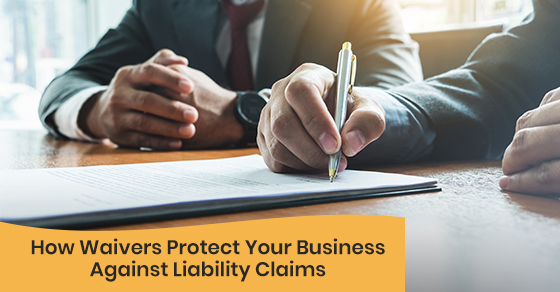
Validity, Applicability, Enforceability – The Use of Waivers in Protecting Your Business against Liability Claims
By: Derek Grieve, Vice President Commercial Lines. W.B. White Insurance Brokers
I was recently asked by a client to review a situation where they allowed a non-member of their organization to participate in sporting activities associated with their club. In this instance, a club member invited a “guest” to their club to participate in a ride along. The member’s guest was asked to pay a small fee and sign a waiver in favour of the club. Following the ride, which went without incident, a discussion arose amongst the membership over the use of the waiver – and more importantly their liability and responsibility should an accident occur on the road.
I love when our clients ask us these questions. It shows they care about their club, but also – and maybe more importantly -it shows that they have concerns about whether the actions of a third party would having a negative impact on their club.
This case involved a bike club, but the principles are fundamental across any business. If the actions of a third party are detrimental to your organization, you should be protected. At the very least, you should have a mechanism in place to REDUCE THE RISK to your organization. (Think Insurance 101)
The Use of Waivers
I tell all of my clients the same thing. There is nothing you can do to ensure 100% protection from any type of claim made against your organization. No one is bulletproof. This belief was borne from my experience providing insurance and risk management advice to clients in the medical malpractice field. I would receive weekly, sometimes daily calls from clients who were nervous or uncertain about treatment they provided to a patient, or from an ‘offhand’ comment one of their patients made and the end of a treatment session. In these cases my message to them was always clear. You can only control what YOU do, not the actions or allegations made by a third party. While the use of a waiver is not an ironclad way of protecting you or your organization, you can take steps to mitigate your risk through a waiver. However, for that waiver to be of any use, it must be Valid, Applicable and Enforceable.
Validity – The “meat and potatoes” of the Waiver
When determining what constitutes a good waiver, one always has to look at how well constructed the waiver is. If a waiver contains ambiguous terminology or is meant to deceive or confuse, courts will always use Contra proferentem which basically means, any ambiguous clause(s) should be interpreted AGAINST the interests of the party that drew up the contract. For this reason, the waiver has to be iron clad. In situations where a waiver is combined with a participant’s exclusion for example, the waiver portion must be clearly stated. Important terms and conditions must be highlighted, bolded, or underlined to show that they have an enhanced contextual meaning and importance throughout the contract.
Applicability – The “relatability” of the Waiver
When you go to the grocery store, are you asked to sign a waiver? The answer is no. A user of the grocery store assumes that a reasonable store owner would keep their business safe, free of latent defects and be a safe environment to go shopping in. A ski resort for example, invites customers on to the property to participate in activities usual and custom to skiing, but which also contains an inherent elevation of risk of injury. This “assumption” of risk creates a contract between two parties that goes beyond that of a grocery store owner and a customer in the example above. What you now have is an agreed upon contract between the owner of the business and the user of the facility. It also creates a duty of care that the owner now owes the user while using the premises. If that duty is breached, the user would then have recourse against the owner of the ski slope if negligence can be proven. As such, this is an extremely important aspect of the contract. The user has to be capable of signing a contract. Factors may include; a) when was the waiver presented to the individual? b) was the individual of age? Intoxicated? under duress? c) were the terms clearly understood? d) did the individual sign the waiver?
Enforceability – Is the waiver worth the paper it’s written on?
In order for the waiver to be enforceable, courts have determined that the releasee to the waiver must fully understand what it is they are signing. In our case, the document must not infringe upon certain rights and responsibilities the ski hill owner owes to the user and probably most importantly, the waiver must contain phrases and language that is understood and accepted prior to engaging in the activity.
The use of a waiver will never provide a 100% defence against your organization, however a properly worded waiver, brought to the attention of a participant who is capable of understanding it, is now an effective tool and in some cases is completely defensible in liability claims.
While W.B. White does its best to provide useful general information and guidance on matters of interest to its clients, statutes, regulations and the common law continually change and evolve, vary from jurisdiction to jurisdiction, and are subject to differing interpretations and opinions. The information provided by W.B. White Insurance Brokers is not intended to replace legal or other professional advice or services. The information provided by W.B. White Insurance Brokers herein is provided “as is” and without any warranty, either express or implied, as to its fitness, quality, accuracy, applicability or timeliness. Before taking any action, consult an appropriate professional and satisfy yourself about the fitness, accuracy, applicability or timeliness of any information or opinions contained herein. W.B. White Insurance Brokers assumes no liability whatsoever for any errors or omissions associated with the information provided herein and furthermore assumes no liability for any decision or action taken in reliance on the information contained in these materials or for any damages, losses, costs or expenses in a way connected to it.
Leave A Comment
The comments are closed.


